There is in the “mythology of madness” the oft repeated story of radical therapy effect by Phillipe Pinel when he released the madmen and madwomen from their chains in Bicetre and Salpetriere hospitals in Paris in 1794. Pinel’s freeing of the madmen and madwomen was said to have ushered in a revolution in the treatment of madness. Not only did he free these men and women from their literal chains, he simultaneously, through their de-incarceration, also freed them from the stigma to which the chain had interminably condemned them beyond repair.
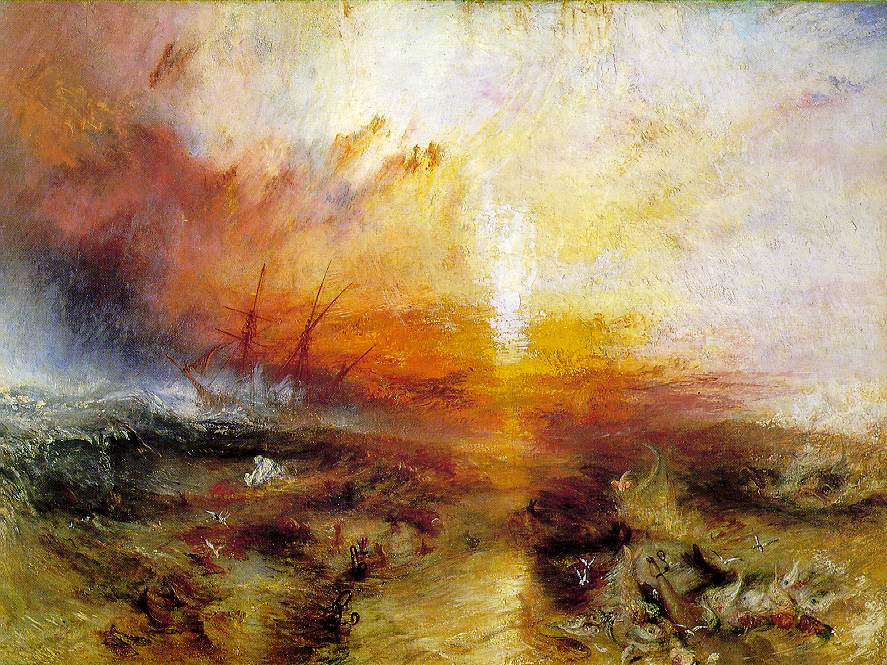
JMW Turner . The Slave Ship. "James Mallord William Turner painted "The Slave Ship" to help an Abolitionist anti-slavery campaign. Today this famous painting hangs in The Boston Museum of Fine Arts. John Ruskin (see The City Review article) called it the one painting he would choose to vouch for Turner's immortality, both for its moral content and its awesome painterliness. The painting shows slaves being tossed into swirling surf filled with hungry sea creatures by slave traders that routinely ploughed the ocean between Africa and the United States."
By the same token, Pinel did not so much free the insane from their hellish confinement as much as he released their madness from total censure. In this way he returned them back into the world, or rather, into the social government of the asylum from which the insane had been banished. And in which for centuries scores languished, under lock and key, behind high walls, where no ‘serene’ gaze of rationality and respectability would ever fall on that insolence that represents the ruined human character.
In Western democracies, race constitutes its own form of madness, along with its own asylums and governmentalities. From the earliest moment that European colonists arrived on American shores,for example, race has been the great alloy of a potent social experiment, one that produced slavery and the plantation economy. If the Bicetre and Salpetriere hospitals were more than therapeutic zones – being as they were places of seizure – the confinement on the plantation under slavery mobilized similar senses of capture and stigma. Race in America simultaneously represents the unspeakable and the irrepressible, as well as an epistemological model of biological differentiation that produces a prodigious body of discourse and representation.
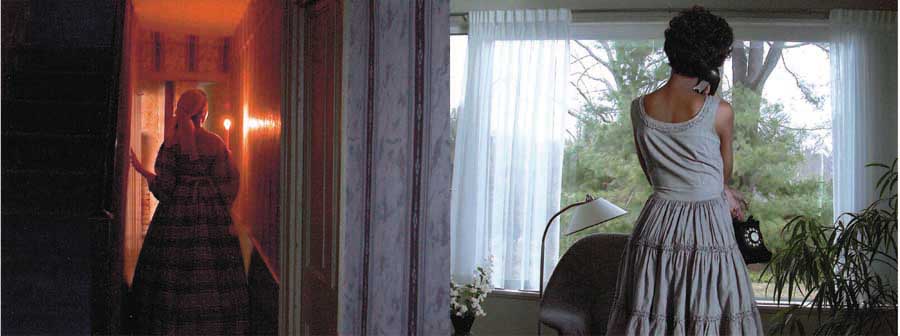
This shift is very effectively captured in Simpson's lyrical film/video "Corridor." in which dual dramas of the past and present occupy the same screen. The left vignette portrays an African American woman dressed as the world once used to see her - as a slave or servant in a plantation house, with white apron, turbaned headdress, and simple calico dress: "Mammy" in "Gone With the Wind."
And like madness in the asylum, it enjoys a particular kind of censure behind the high walls of its own asylum. Except, unlike the asylum, which is ringed by thick, mortared walls and protected by a forbidding gate, the madness of race exists nakedly visible in the tumescent flesh of the American social ideal and is practiced in the open terrain of the cultural landscape.
Thus, is identity based on attitude or belief system at the intersection of race and gender? There seems to be a lot of false premises to choose from from which to construct our lives, and much of it superficial and inconsequential. Still waters can run deep; lingering unease and proliferating sets of doubts mark their time. We blindly accept images as truth, yet there is also a power of the “voided” image and how that impacts on identity. And is reality actually what one makes of it? Is reality tangibly ”out there” or is it all an illusion or delusion of our minds, which cannot differentiate between real and unreal, fact and fantasy?

"What happened outside the frame of this beautifully, knowingly Raphaelesque image of a black woman in a white shift with disheveled hair, seen from behind against a very dark ground, emptying a silver pitcher with one graceful arm and a plastic jug with the other? A rape? An escape? A lynching? Who is this witness to an invisible event, who is herself invisible? A nineteenth-century slave or a twentieth-century citizen, whose citizenship still doesn't count? The complex poignancy of those questions about what is unseen is enhanced, rather than undercut, by the stylish play with what is seen, including black skin, white shift, and silver pitcher (in which it matters that this is a black-and-white gelatin silver print)."
“…it appears as if this film is furthering the divide between cultures. Pointing out cultural and religious differences that are purely superficial, even if it be through comedy furthers separation and hate between cultures. If humanities ultimate goal is peace then recognizing similarities in our cultures is important rather than differences.
“We have created you male and a female; and we have made you into nations and tribes so that you may know one another”
“The whole of the Torah is for the purpose of promoting peace” …

"One of the nicer moments in the film is when Mahmud puts on a kippah, then panicks and places a taqiyah on top of it -- for the next few scenes, he’s walking around with a Jewish headpiece underneath a Muslim prayer cap, and it perfectly represents his struggle at being outwardly committed to one faith while inwardly born into another. Read more: http://www.natioThis is what happens when a middle-aged Muslim man suddenly discovers that he is actually Jewish.
“…as I completely disagree that this film has an influence to make a divide larger than it already is. Personally I think it highlights an awareness of the current divide that exists. The only thing that makes a divide is people and there actions behind there beliefs.I beleive you can still have a culture a religion and accepting/respecting other cultures and bel
War does not grow on trees its people strong beliefs also greed that can cause a war the same applies to segregation/divide. Its only a comedy that should be treated as a commedy….To treat this any differently than a commedy would be suggesting/demanding negative divide that no one wants in my opinion. ( www.arabist.net, Issandr El Amrani )
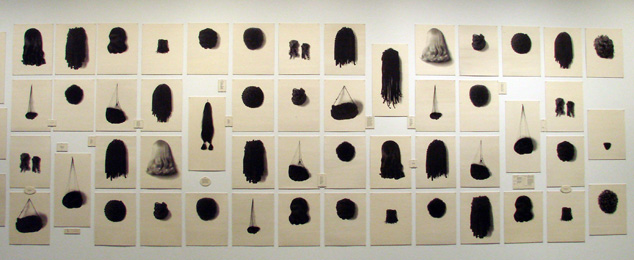
"Ultimately, Simpson's art is not about victimization - that is firmly left behind in the dust. Her modern imagery is about taking back the power, and carving a new African-American niche, or female niche, however the viewer chooses. The truths exposed in Simpson's art - and she is truthful - are grounded in the footprints of history, with all the painful realities picked clean from the carcass, the bones laid bare. There is a sadness in her vision, but a sense of moving forward, of independence from the chains of memory."
Josh Appignanesi’s new film The Infidel not only has its opinions; it wears them on its sleeve, even though it may be short sleeves. It’s about a Muslim who discovers, while going through his recently deceased mother’s papers, that he was adopted. His birth records contain an even more shocking fact: He’s Jewish. Through a series of events, he comes to embrace his Hebraic roots while also strengthening his devotion to Islam. The fact that he’s British, but of Pakistani origin, occasionally comes into play as well, but this is more about faith than nationality. The premise is very intriguing, since it shows how fragile identity is, and how easily it can collapse. The film itself is pretty average; too much below the belt generic laughs to keep it far from the proximity of the Adam Sandler nation.
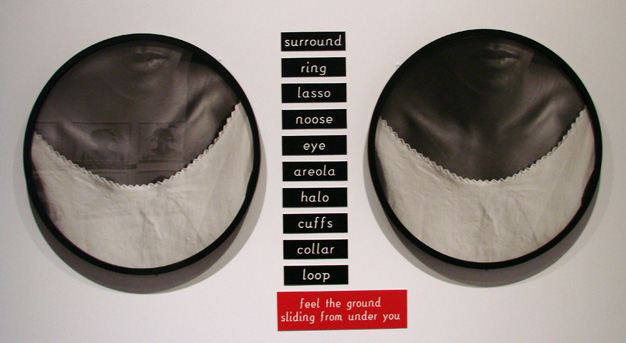
"Suddenly, the play among the surfaces of "black" skin, "white" fabric, and "silver" print became vibrant, making me pause and seriously question what was black, what was white, what was gray or silver or in-between, and whether what I was seeing was "real" or not. (For several moments, what I knew to be silver print looked like it was really white fabric, and the texture of skin began to trade places with that of emulsion-coated paper.) And in turn, that ambivalence brought to life the multivalence of the words between the two circular frames, and their sliding between the states of noun and verb, between body and sex and their policing, and gave way to the bright red of the groundlessness of semiosis and point of view, and above all to the vividly colored vertigo of human desire. This is matter and thought working together, as it is the business of visual art to bring about, to have a real effect on a viewer who consists of a thinking mind in a sensing body, however that mind and body are gendered and raced."
British comedian Omid Djalili plays Mahmud Nasir — or, as his adoption papers reveal, Solly Shimshillewitz. (Nasir’s neighbour asks: “Why didn’t they just call you Jewy-Jew-Jew-Jew-Jew and be done with it?”) Anxious to reconcile with his aging father, he first decides he must “Jew up” enough so as not to shock the old man. Enter Richard Schiff as Lenny Goldberg, Nasir’s cab-driver neighbour, who agrees to instruct Nasir in the fineries of Jewish thingies, Fiddler on the Roof and a few yiddishisms.
Appignanesi was probably intrigued by the identity-swap aspects of the story, seen in films such as Trading Places.Essentially, its the old switched at the cradle premise, where this new Moses in the form of a Homer “Saladin” Simpson, is not in line to the throne of the Pharaoh. The Infidel lacks the traditional “assimilation narrative,” in which the question usually is, how far does one assimilate. The set up being ethnic minority against majority culture. The Infidel’s narrative structure is based on a dialogue between two minority cultures; two groups which are no stranger to the politics of oppression.
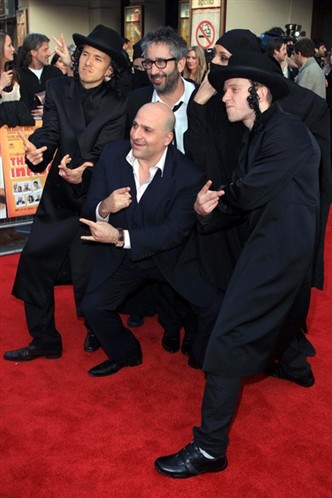
" We meet him in London as Mahmud, a second-generation Anglo-Pakistani who has assimilated all too well. Short, chubby and balding, speaking with a rude Cockney accent, the guy is an East Asian Bob Hoskins with a vocabulary to match – the kind who arms every sentence with a payload of f-bombs. As for his faith, Mahmud is a “relaxed Muslim,” relaxed enough to go light on his daily prayers and heavy on his pale ale."
Another play on the conflicts of identity is in Howard Jacobson’s new book “The Finkler Question”. Surprisingly, the main character in his new novel, Julian Treslove, is a Gentile. Sort of. Though Treslove may not be Jewish, he caught that particular Jewish virus that leads one to be obsessed with Jews and Jewishness for better or double portions of neuroses. One day, Treslove is mugged by someone who, he later becomes convinced, used the words “you Jew” during the attack. This sets him to thinking, maybe he is Jewish. Before long, he’s brushing up on his Yiddish, wondering if it’s too late to get circumcised and moving in with a woman called Hephzibah Weizenbaum. There’s also a full supporting cast representing every possible shade of Jewish opinion. It seems predictable stuff and kind of fluffy but the obligatory political messages are combined with unsparing ruminations on love, ageing, death and grief; a relentless commitment to re-examining even the most seemingly unobjectionable of received wisdoms, elevates the whole and the quality of writing appears first rate.
“In short, I admire what seems to be( Lorna) Simpson’s counterview to a prevailing idea, nourished by many strands of “theory” in the academy and by garden-variety “identity politics” in and outside of the academy alike, namely, that aesthetic engagement amounts to bad faith. On the contrary, the bad faith lies in the easy conventionality with which the antiaesthetic view aligns itself with the critical and the subversive. Bravo to artists of any affiliation whose work does not fall in line with such unthinking carelessness. It is time to think anew about such matters: about what “identity” is, and what “aesthetics” can do with it. Good to know I am not alone in thinking so.” ( Carol Armstrong )








 COMMENTS
COMMENTS



